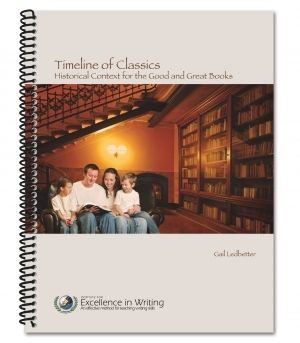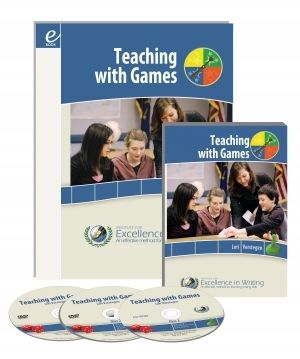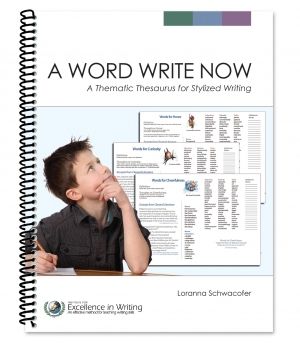Timeline of Classics
 Of the three resources, the one I'm the most excited about is Timeline of Classics by Gail Ledbetter. This is a well-chosen book list of classic literature, biographies, the very best of historical fiction, and even plays and films, all arranged chronologically. It is divided by time period: Ancients, The Middle Ages, Renaissance and Reformation, and The Modern World. The pages are very simply laid out with just the right amount of information: a description of the time period and/or the setting, title, author, and the level each resource is appropriate for (Elementary, Middle, or High School). Each page also has an intriguing quote from one of the recommended books.
Of the three resources, the one I'm the most excited about is Timeline of Classics by Gail Ledbetter. This is a well-chosen book list of classic literature, biographies, the very best of historical fiction, and even plays and films, all arranged chronologically. It is divided by time period: Ancients, The Middle Ages, Renaissance and Reformation, and The Modern World. The pages are very simply laid out with just the right amount of information: a description of the time period and/or the setting, title, author, and the level each resource is appropriate for (Elementary, Middle, or High School). Each page also has an intriguing quote from one of the recommended books.Since we are studying the Middle Ages right now, I turned to that section of the book. I could see at a glance which resources were appropriate for elementary school. I opened my library's website and started searching for and reserving the titles that sounded interesting: The Sword in the Tree; The Making of a Knight; Castle Diary... I noticed a recommendation for a historical atlas, and thought, "Yes! I need to buy one of those." (I had just been trying to google historical maps online with very limited success.)
Any homeschooler that uses a literature based approach for history will appreciate this resource. It hits just the right balance of selectivity and comprehensiveness, and could easily be used as the basis of all your history studies on its own. I anticipate referencing it regularly for years to come.
 Teaching with Games
Teaching with Games
The resource my boys were most excited about was the Teaching with Games Set. This parent/teacher resource includes two DVDs containing workshops led by Lori Verstegen on teaching with games, a spiral-bound book with rules and templates for all the games, and a CD-ROM with a PDF of the book and some bonus materials (extra games!). There are twenty games, most adaptable to any age group, many adaptable to more than one subject area. The games range from "No-Prep" games that require nothing more than a piece of paper (at the most), to matching games, Jeopardy-type question games, math games, and "Make as You Teach" games.
I was amused with the fascination this set held for my boys. It is a parent resource, but SA(7) spent hours poring over the instructions for the games, and JJ(5) immediately chose "The Space Game" (a home-made board game) as his favourite. They both watched the game demonstrations on the DVDs with me. We played several of the games, and as usual in this house, the math games got played the most.
"Fun Times" was a big hit, providing plenty of multiplication practice. I chose to make our own game board for this with multiplication facts between 1x1 and 6x6. (The original had multiplication facts from 2x5 to 7x10, and required modifying a pair of dice.) SA and I (or JJ, who soon figured out how to find the answers on the board based on the factors on the top and side...) took turns rolling the dice and multiplying the two numbers on the dice. We put our tokens on the answers, and the first person with four in a row was the winner. The game had some twists to add to its excitement...rolling doubles and landing on shaded squares on the board had special consequences.
Teaching with Games is a worthwhile resource that could be helpful to Sunday-school teachers and classroom teachers as well as homeschoolers. To be perfectly honest, I can be a bit lazy about coming up with games or activities to go with our studies. The boys were very pleased that I got to review this, and I'm sure they will keep me using it for some time to come.
A Word Write Now
The last resource I used was A Word Write Now. This student thesaurus by Loranna Schwacofer is creatively organized by character traits, descriptive words, and words for movement and the senses. The idea is that children do not always know exactly what word they are looking for. This thesaurus directs the student to a category of words and provides a range of ideas as to how they could express themselves using different parts of speech. Each page also includes examples from classic literature.
My boys are not old enough to use a thesaurus, so I used it myself. I often consult an online thesaurus as I blog, so I thought perhaps this one would do as well. It was not really a good fit for my purposes. My use of a thesaurus usually goes like this:
- I notice I'm overusing a word
- I type the word into a search engine
- I pick a better word from the synonyms that come up.
I'm very task-oriented in my thesaurus use, in other words. This thesaurus is more oriented to creativity. It is all about exploring and enjoying words. I expect it will be very useful at some stage as my children learn to write, but we're not there yet.
If you are looking for a student thesaurus, I suggest you check out the samples online at Institute for Excellence in Writing and see if this is something that might work for you.
Other bloggers on the Schoolhouse Review Crew have reviewed these resources and also Phonetic Zoo Spelling from Institute for Excellence in Writing. Click on the link below to see what they have to say!





